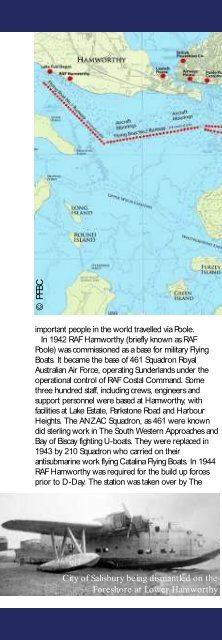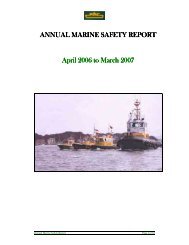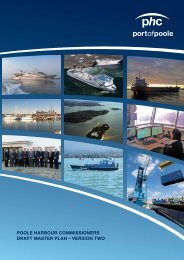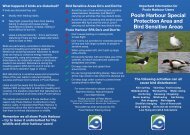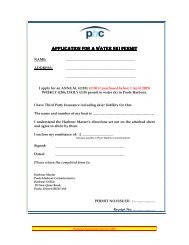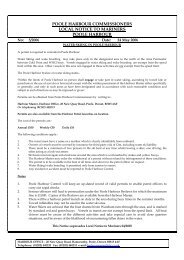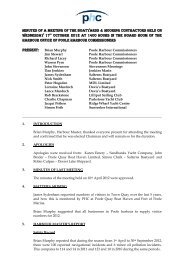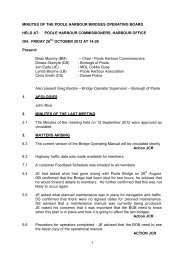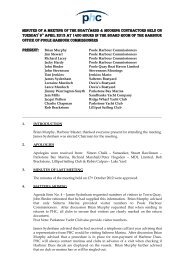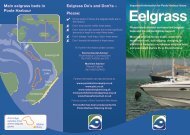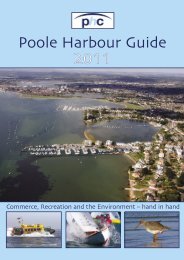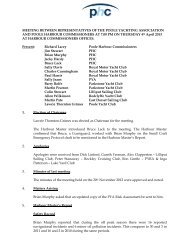The Poole Harbour Guide 2012 - Poole Harbour Commissioners
The Poole Harbour Guide 2012 - Poole Harbour Commissioners
The Poole Harbour Guide 2012 - Poole Harbour Commissioners
Create successful ePaper yourself
Turn your PDF publications into a flip-book with our unique Google optimized e-Paper software.
© PFBC<br />
important people in the world travelled via <strong>Poole</strong>.<br />
In 1942 RAF Hamworthy (briefly known as RAF<br />
<strong>Poole</strong>) was commissioned as a base for military Flying<br />
Boats. It became the base of 461 Squadron Royal<br />
Australian Air Force, operating Sunderlands under the<br />
operational control of RAF Costal Command. Some<br />
three hundred staff, including crews, engineers and<br />
support personnel were based at Hamworthy, with<br />
facilities at Lake Estate, Parkstone Road and <strong>Harbour</strong><br />
Heights. <strong>The</strong> ANZAC Squadron, as 461 were known<br />
did sterling work in <strong>The</strong> South Western Approaches and<br />
Bay of Biscay fighting U-boats. <strong>The</strong>y were replaced in<br />
1943 by 210 Squadron who carried on their<br />
antisubmarine work flying Catalina Flying Boats. In 1944<br />
RAF Hamworthy was required for the build up forces<br />
prior to D-Day. <strong>The</strong> station was taken over by <strong>The</strong><br />
City of Salisbury being dismantled on the<br />
Foreshore at Lower Hamworthy<br />
Special Feature<br />
Royal Navy and renamed HMS Turtle. In the early<br />
1950s the former RAF Hamworthy site was used for the<br />
storage of Flying Boats prior to many of them being<br />
sold, scrapped and disposed of when operations, both<br />
military and civil ceased.<br />
From July 1940 – 1945 the site of <strong>The</strong> Royal Motor<br />
Yacht Club (and other nearby locations) were<br />
requisitioned by <strong>The</strong> Fleet Air Arm as a base, becoming<br />
the Royal Naval Air Station Sandbanks (HMS Daedalus<br />
II). <strong>The</strong> base was used for aircrew training and essential<br />
air rescue work, using Walrus Seaplanes, fondly referred<br />
to as the “shagbat”. Alas, the station, along with RAF<br />
Hamworthy suffered casualties in the war, as did BOAC,<br />
but no passengers travelling from <strong>Poole</strong> were injured, a<br />
very proud and remarkable record.<br />
<strong>The</strong> Navy took good care of the RMYC, but even to<br />
this day the boat shed, which was used for storage and<br />
maintenance, has a sign on the wall saying “A hot engine<br />
is always on contact”, a reminder of those days!<br />
<strong>The</strong> end of the Flying Boat era came shortly after the<br />
end of the war. In 1948 BOAC civil operations were<br />
returned to Southampton, ceasing in 1950. All that<br />
remains are memories, which the PFBC keep alive. <strong>The</strong><br />
charity has a considerable archive, some of which<br />
appears on their website:<br />
www.pooleflyingboats.com<br />
47


